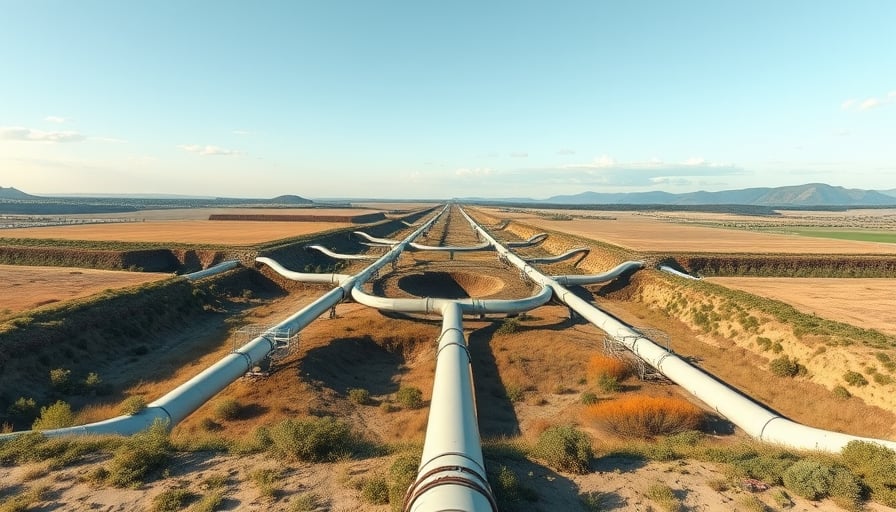Enbridge’s Recent Regulatory Approvals and Their Implications for Energy Markets
Enbridge Inc. has secured approvals from the U.S. Army Corps of Engineers to reroute a segment of its aging oil pipeline around a northern Wisconsin tribal reservation and to encase a portion of the pipeline beneath a Great Lakes channel. These regulatory decisions are pivotal for the company’s safety and environmental strategy and have broader repercussions for supply–demand dynamics, infrastructure investment, and the transition to low‑carbon energy systems.
Supply‑Demand Fundamentals in the North American Energy Corridor
The rerouting and encapsulation projects enhance the reliability of a key trans‑North American oil corridor that feeds Canadian crude into the U.S. Midwest and Gulf Coast markets. With global oil demand expected to remain in the 100‑110 million barrels per day range through 2026, any incremental improvement in pipeline security reduces the risk of supply disruptions that could otherwise trigger price volatility.
From a commodity‑price perspective, crude futures for West Texas Intermediate (WTI) have traded between $80 and $90 USD per barrel in the last quarter, reflecting a tight market that has been buffeted by geopolitical tensions in the Middle East and supply constraints in OPEC+. Enbridge’s infrastructure upgrades are likely to be priced into the spread between Canadian crude and U.S. benchmarks, reinforcing the corridor’s role as a low‑cost delivery channel.
Technological Innovations in Pipeline Safety and Energy Production
The encasement of the pipeline under a Great Lakes channel exemplifies a shift toward “smart” protective measures that combine structural reinforcement with real‑time monitoring systems. Modern pipelines increasingly integrate fiber‑optic sensors, pressure‑monitoring devices, and automated leak‑detection algorithms. Enbridge’s investment in these technologies not only mitigates environmental risk but also lowers the operating cost of pipeline maintenance, thereby improving the company’s return on capital.
In the broader context, the energy sector is witnessing a convergence of traditional and renewable production technologies. Natural gas, which Enbridge transports, is being repurposed as a bridge fuel in power generation while battery‑energy storage and hydrogen production facilities are scaling up. The company’s midstream operations, which include natural‑gas pipelines and storage, are thus positioned to support emerging decarbonization pathways by facilitating the transport of cleaner fuels.
Regulatory Impact on Traditional and Renewable Energy Sectors
The U.S. Army Corps’ approvals signal a regulatory environment that balances environmental stewardship with energy security. By endorsing Enbridge’s safety measures, the Corps underscores a broader policy trend that incentivizes infrastructure retrofits and resilience upgrades. Such regulatory frameworks are expected to encourage other pipeline operators to adopt similar technologies, potentially creating a market for pipeline‑enhancement services.
Conversely, renewable energy developers are increasingly eyeing midstream assets to secure gas supply for power plants that are intermittently running alongside wind or solar farms. The integration of Enbridge’s gas network with renewable projects could foster hybrid generation schemes that improve grid reliability. The regulatory approval also removes a potential bottleneck for projects that depend on pipeline access for natural‑gas input, thereby accelerating the deployment of renewable‑augmented power plants.
Commodity Price Analysis and Infrastructure Development
Recent data indicate that natural‑gas spot prices have spiked by 15 % over the past six months, largely due to storage constraints and heightened demand for heating and power generation in the U.S. Midwest. Enbridge’s strategic enhancements to its pipeline infrastructure are likely to reduce transportation bottlenecks, potentially moderating price swings in the near term.
Furthermore, the company’s investment in electric distribution and retail energy products positions it to capture value from the shift toward distributed generation. Grid modernization projects, including the installation of advanced metering infrastructure, are projected to increase demand for Enbridge’s transmission services by up to 8 % annually through 2030.
Short‑Term Trading vs. Long‑Term Transition
Short‑term traders will be attentive to Enbridge’s stock performance relative to its 52‑week high, as the market absorbs the implications of the new approvals. While the stock remains relatively stable, any delay or additional regulatory hurdle could trigger a negative reaction, especially among investors focused on ESG metrics.
In the long term, Enbridge’s commitment to pipeline safety and its expanding role in midstream services align with the gradual pivot toward decarbonization. The company’s infrastructure upgrades not only mitigate immediate risks but also provide the flexibility to adapt to future energy mixes that may incorporate natural‑gas, hydrogen, and renewable fuels. As the transition unfolds, Enbridge’s integrated asset base is expected to serve as a linchpin in North America’s energy supply chain, balancing profitability with sustainability.




